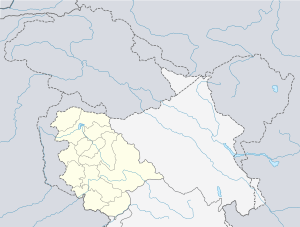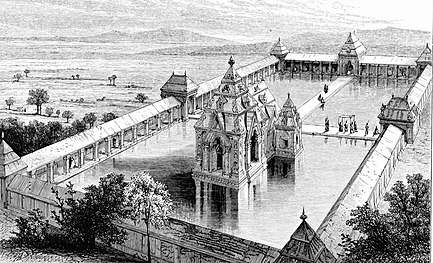Martand Sun Temple
The Martand Sun Temple is a Hindu temple dedicated to Surya (the chief solar deity in Hinduism) and built during the 8th century CE. Martand is another Sanskrit synonym for Surya. Now in ruins, the temple is located five miles from Anantnag in the Indian union territory of Jammu and Kashmir. The temple was destroyed on the orders of Sultan Sikandar Butshikan, as part of his efforts to forcibly convert Kashmiri people to Islam.[1][2]
| Martand Sun Temple | |
|---|---|
Martand Surya Temple | |
.jpg) Martand Sun Temple Central shrine | |
| Religion | |
| Affiliation | Hinduism |
| District | Anantnag |
| Deity | Martand (Surya) |
| Location | |
| Location | Anantnag |
| State | Jammu and Kashmir |
| Country | India |
 Location in Jammu and Kashmir  Martand Sun Temple (India) | |
| Geographic coordinates | 33°44′44″N 75°13′13″E |
| Architecture | |
| Creator | Lalitaditya Muktapida |
| Completed | 8th century CE |
History
The Martand Sun Temple was built by the third ruler of the Karkota Dynasty, Lalitaditya Muktapida, in the 8th century CE.[3][4] It is said to have been built during 725-756 CE.[5] The foundation of the temple is said to have been around since 370-500 CE, with some attributing the construction of the temple to have begun with Ranaditya.[6][7]
The temple

The Martand temple was built on top of a plateau from where one can view whole of the Kashmir Valley. From the ruins and related archaeological findings, it can be said it was an excellent specimen of Kashmiri architecture, which had blended the Gandharan, Gupta, Chinese, Roman, Syrian-Byzantine and Greek forms of architecture.[8][9]
The temple has a colonnaded courtyard, with its primary shrine in its center and surrounded by 84 smaller shrines, stretching to be 220 feet long and 142 feet broad total and incorporating a smaller temple that was previously built.[10] The temple turns out to be the largest example of a peristyle in Kashmir, and is complex due to its various chambers that are proportional in size and aligned with the overall perimeter of the temple. In accordance with Hindu temple architecture, the primary entrance to the temple is situated in the western side of the quadrangle and is the same width as the temple itself, creating grandeur. The entrance is highly reflective of the temple as a whole due to its elaborate decoration and allusion to the deities worshiped inside. The primary shrine is located in a centralised structure (the temple proper) that is thought to have had a pyramidal top - a common feature of the temples in Kashmir. Various wall carvings in the antechamber of the temple proper depict other gods, such as Vishnu, and river goddesses, such as Ganga and Yamuna, in addition to the sun-god Surya.[11]
Portrayals in Popular Culture
- 1970: Bollywood movie Man Ki Aankhen starring Dharmendra and Waheeda Rahman has Martand Temple as background for the Rafi-Lata song Chala Bhi Aa Aaja Rasiya[12].
- 1975: Bollywood movie Aandhi starring Sanjeev Kumar and Suchitra Sen has Martand Temple as background for the Kishore-Lata song Tere Bina Zindagi Se Koi Shikwa Nahiin[13].
- 2014: Martand Temple was selected as the background for the song Bismil, in the popular Bollywood movie Haider. The movie is modelled on Shakespeare's Hamlet in the backdrop of Kashmir conflict. In the movie the temple was shown as a place of evil. This partially led to the controversy surrounding the movie. Anupam Kher criticised director Vishal Bhardwaj for shooting the Devil’s Dance sequence in the temple, resulting in humiliation to Kashmiri Pandits.
Site of National Importance
The Archaeological Survey of India has declared the Martand Sun Temple as a site of national importance in Jammu and Kashmir.[14] The temple appears in the list of centrally protected monuments as Martanda (Sun Temple).[15]
References
- "Martand Sun Temple: Obscured By Neglect". HuffPost India. 22 July 2015. Retrieved 15 June 2020.
- A History of Kashmir by Pandit Prithvi Nath Kaul Bamzai. p. 140.
- Animals in stone: Indian mammals sculptured through time By Alexandra Anna Enrica van der Geer. 2008. pp. Ixx. ISBN 978-9004168190.
- Gupta, Kulwant Rai (2006). India-Pakistan Relations with Special Reference to Kashmir By Kulwant Rai Gupta. p. 35. ISBN 9788126902712.
- Goetz, Hermann (1955). The Early Wooden Temples of Chamba. Brill Archive. pp. 50, 66.
martand sun.
- "Tourist places in south Kashmir". alpineinpahalgam.com. Retrieved 8 July 2012.
- "Martand House of Pandavs". Search Kashmir. Retrieved 11 July 2012.
- Wink, André (1991). Al-Hind, the Making of the Indo-Islamic World, Volume 1 By André Wink. pp. 250–51. ISBN 9004095098.
- Chaitanya, Krishna (1987). Arts Of India By Krishna Chaitanya. p. 7. ISBN 9788170172093.
- Encyclopædia Britannica: a new survey of universal knowledge: Volume 12, pp:965
- Kak, Ram Chandra. "Ancient Monuments of Kashmir". koausa.org. Retrieved 8 November 2014.
- "Chala Bhi Aa Aaja Rasiya | Lata Mangeshkar, Mohammed Rafi | Man Ki Aankhen 1970 Songs | Dharmendra". Retrieved 4 February 2020 – via www.youtube.com.
- "Tere Bina Zindagi Se Koi Shikwa To Nahin | Lata Mangeshkar, Kishore Kumar | Aandhi 1975 Songs". Retrieved 4 February 2020 – via www.youtube.com.
- "Archaeological survey of India protected monuments". heritageofkashmir.org. Retrieved 11 August 2012.
- "Protected monuments in Jammu & Kashmir". asi.nic.in, Archaeological surey of india. Archived from the original on 7 May 2012. Retrieved 29 October 2012.
External links
| Wikimedia Commons has media related to Sun Temple, Martand. |
- Indira Gandhi National Centre for the Arts - Martand Sun Temple Site Photos
- Martand Sun Temple in winter - Pics of Surya Sun Temple under snow
- Martand Sun Temple and around
a)A History of Kashmir by Pandit Prithvi Nath Kaul Bamzai , pp.140

